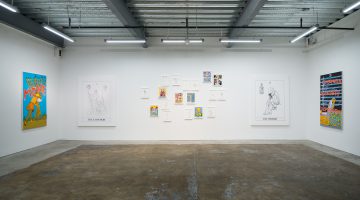Dancing with the Art World, a two-day symposium at the Hammer Museum, as organized by Brennan Gerard and Ryan Kelly, MFA candidates, Interdisciplinary Studio, UCLA Department of Art with faculty adviser Andrea Fraser, started with an impactful opening address succinctly covering what was to be questioned, examined, performed in the platform of a critical reflection between the two parties: dance and art. A negotiation of words, exchanged thoughts, and movements, between dance and the art world. Where do the two want to collide? What lens are necessary to consider the matters at hand? Should dance even be written into the art world frame? The institutional frame? How does the dancer survivor in the art world? How does the artist sustain living in the current art economy? Is dance to be collected? What is at risk of the loss of ephemeral in dance? How can the preservation of dance become educational and not merely idolatry? How is dance to survive outside and inside the frame? Can we even talk about dance? Can dance only be expressed through dance? How is collaboration and exchange mitigated between Dance and the Art World?

Trisha Brown, “Untitled,” 2007. Charcoal, pastel on paper. Harvard Art Museums / Fogg Museum, Margaret Fisher Fund. Photo: Katya Kallsen. © President and Fellows of Harvard College.
In their opening address, Gerard and Kelly noted of the rise of the dance world being embraced by the art world in the past 5-10 years with exhibitions and retrospectives in museums and galleries alike. From Move: Choreographing You at London’s Hayward Gallery (2008) to Dance/Draw at the Institute of Contemporary Art Boston (2011) to Danser sa vie at the Centre Pompidou in Paris (2012) to Dancing around the Bride: Cage, Cunningham, Johns, Rauschenberg at the Philadephia Museum of Art (2012- 2013) to the Walker Art Center’s acquisition of the Merce Cunningham Dance Collection (2011). It is from this optimistic momentum that Gerard and Kelly closed with the complicated, yet necessary, conversation of economy and compensation when it comes to such ephemeral forms of art. How does the artist survive when they leave no object behind for the collector to buy? How are we to fund such post-studio non-object practices that are attempting to divert, avert, connect with the human form outside of a sole conversation in the market? There has no hiding of the long-esteemed love affair between the visual arts and dance, but is a new social, political, and economic system on the horizon bringing these two together in a more strengthened partnership?

Janine Antoni, “Loving Care,” 1993. Performance with Loving Care hair dye in “Natural Black,” Anthony d’Offay Gallery, London, September 10, 1993. Photographed by Prudence Cumming Associates, Courtesy of the artist and Luhring Augustine, New York. © Janine Antoni.
A feature-length film of Merce Cunningham Dance Company’s last performance at the Armory was then screened transcending us into this final hurrah as dancers moved on and off various stages as if frenzied atoms displaying patterns of elegance and affection. This postmodern dance capturing was followed by postmodern theorist, Douglas Crimp, who walked the atypical line of classicism through his affection of the ballet, and addressing ballet’s presence as a taboo in the Dance/Art World. Crimp indulged us in his past frequent rendezvous at the New York City Ballet with fellow critic and October contributor Craig Owens where he shared a “formative experience from an oblique angle very high up” as those were there affordable seats as they attended four to five times a week. Crimp was then joined by Mary Kelly, who is the director of Interdisciplinary Studio MFA program at UCLA, for some responding questions. Kelly brought up possibilities on queering the museum’s frame and questions if dancer even want to be in the art world frame. The evening ending shortly thereafter and we all shuffled into the night for a goods night rest in preparation for the Saturday ahead of us or a Friday night full of dancing for some, who is to judge one’s rests or movements, the institution or ourselves?
Dancing with the Art World Day 1 sets the stage for a packed day 2 to unravel where: “a working group of artists, choreographers, curators, and historians to structure a space for critical reflection on the recent interface between dance and art, consider its historical precedents, and debate its effects on artistic and institutional practice.”
Contributed by Brigitte Nicole Grice
For more information visit here.





